Lawn Disease Identification and Control in Chesterfield Twp.
Leaf Spot
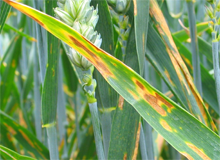 This disease is caused by several types of Helminthosporium fungi. Several common names such as melting out. crown rot and leaf blight are also used to describe this common turf problem. Leaf spot is probably the most widespread of all lawn diseases
This disease is caused by several types of Helminthosporium fungi. Several common names such as melting out. crown rot and leaf blight are also used to describe this common turf problem. Leaf spot is probably the most widespread of all lawn diseasesTurf infested with leaf spot or crown rot is thinned and oflen looks as though it is suffering from drought or is mistaken for insect damage. Many people water their lawns, thinking they are drying out. Actually, excessive moisture will accelerate the spread of the disease. In addition to too much moisture, close mowing and infrequent mowing also aggravate the disease. Letting the grass get very tall and then cutting it back, or mowing with a dull blade, weakens the plants and allows the leaf spot disease to enter the plant system. This is probably the most common homeowner mistake that leads to leaf spot activity.
Dollar Spot Disease
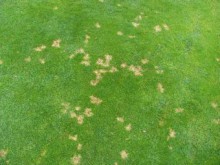 The fungus SOLEROTINIA HOMECARPA causes dollar spots, a turf disease which can attack a number of different grass varieties. The outbreak of dollar spot is affected by soil moisture, nitrogen levels, grass variety, humidity, mowing practices, and temperature.
The fungus SOLEROTINIA HOMECARPA causes dollar spots, a turf disease which can attack a number of different grass varieties. The outbreak of dollar spot is affected by soil moisture, nitrogen levels, grass variety, humidity, mowing practices, and temperature.Necrotic Ring Spot
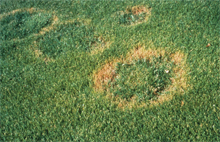 Necrotic Ring Spot is a disease which attacks and kills the root system of bluegrass sodded lawns. This problem usually starts within 2-5 years of establishment of new sodded lawns and heavy clay sub soils seem to have earlier outbreaks than sandy or loam soils.
Necrotic Ring Spot is a disease which attacks and kills the root system of bluegrass sodded lawns. This problem usually starts within 2-5 years of establishment of new sodded lawns and heavy clay sub soils seem to have earlier outbreaks than sandy or loam soils.- Use only slow release, dry granular fertilizers (Warner Landscape uses only this material). Never apply any liquid fertilizers, as they are hotter and heat up soil temperatures!
- Mow as tall as possible! This helps shade the soil, reducing heat stress and allows for more water retention. Also, keep the mower blade sharp and mow regularly (every 5 to 7 days)
- Watering — this is the most important thing to do for prevention and recovery for this disease. Short daily waterings when temperatures are near 80 degrees or above during the honest part of the day is a MUST! Try to water between noon and 4:00pm. This will reduce soil temperatures and allow for continued root growth.
- Turf aeration — annual turf aerating will help stimulate root growth, allow deeper root penetration and let more air, water and nutrients reach the root zone.
- Fungicide treatment (yes or no)? Many times, by simply changing your cultural practices, such as mowing, watering, etc. may help to control NRS disease activity. The only thing left to try is a special fungicide treatment. Fungicides are quite expensive, but if they work, it is well worth the cost of this treatment.
Snow Mold
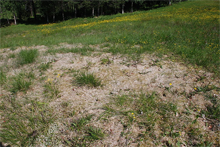 This disease may occur any time from late fall until early spring when temperatures range from 28 to 45 degrees. An excessive amount of moisture or melting snow must be present. Snow mold is more likely to occur on grass that was too tall as it entered the winter. The long. matted down blades of grass provide an ideal environment. Damage is most severe when snow covers the grass for a long period.
This disease may occur any time from late fall until early spring when temperatures range from 28 to 45 degrees. An excessive amount of moisture or melting snow must be present. Snow mold is more likely to occur on grass that was too tall as it entered the winter. The long. matted down blades of grass provide an ideal environment. Damage is most severe when snow covers the grass for a long period.
Gray snow mold is more common on home lawns. Pink snow mold is usually confined to golf course putting greens. Gray snow mold can spread to form large diseased areas. Grass within these areas become matted. closely pressed to the ground and often is completely destroyed
PREVENTION NEXT YEAR
Mow your lawn short in the fall and keep mowing it as long as it needs it. (This may be until almost Thanksgiving.)
Fairy Ring
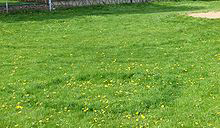 The name Fairy Ring comes from the shape of the rings you may have noticed on your lawn, circular or half moon shape.
The name Fairy Ring comes from the shape of the rings you may have noticed on your lawn, circular or half moon shape.Mushrooms
 Mushroom growth on our lawns is a very common occurrence with all turf varieties.
Mushroom growth on our lawns is a very common occurrence with all turf varieties.
Mushrooms appearing for no reason
Afier periods of high humidity and heavy rainfall organic material deep in the soil starts to decompose, i.e. Tree roots, stumps, building material, usually wood. As this material decomposes it releases nitrogen gases up through the soil and the fruiting bodies
(mushrooms) start to form.
Quick Quote
If you have any questions about insect or disease prevention and control, please contact Warner Landscape and Sod. We are a professional turf care and management company, proudly serving the Chesterfield Twp, MI. area. For all of your landscape, sod and lawn care needs.
Servicing: Macomb Twp, Livonia, St. Clair Shores, Harrison Twp., Gross Pointe, Sterling Heights, Clinton Twp., New Baltimore, Chesterfield, Chesterfield Twp., Warren, Roseville
